Having revealed the design for Candlestick Point, Block 9a, which is intended to set the “sense of place” for the neighborhood, we now turn our attention to the timing and plans for blocks 6a and 8a, both of which will front the future Wedge Plaza and transit hub and are slated to be two of the first Candlestick blocks to be redeveloped.
As designed by BAR Architects, the buildings on the two blocks will rise up to seven (7) stories in height, with a total of 255 condominiums over parking for 214 cars and nearly 30,000 square feet of ground floor retail space fronting the future Harney Way.
The development of the two blocks would step down along 8th Street, 7th Street and Candlestick Park Drive, leading to a row of 22 three-story town homes fronting a mid-block break between Harney Way and C Street.
Construction of the two blocks is expected to commence in the fall of 2018, which would lead to the buildings being ready for occupancy around the end of 2019.
And once again, while the overall redevelopment of Candlestick and Hunters Point will take two to three decades to complete, the redevelopment will yield over 12,000 new or rebuilt homes, around 1,500 of which should be completed over the next five years.

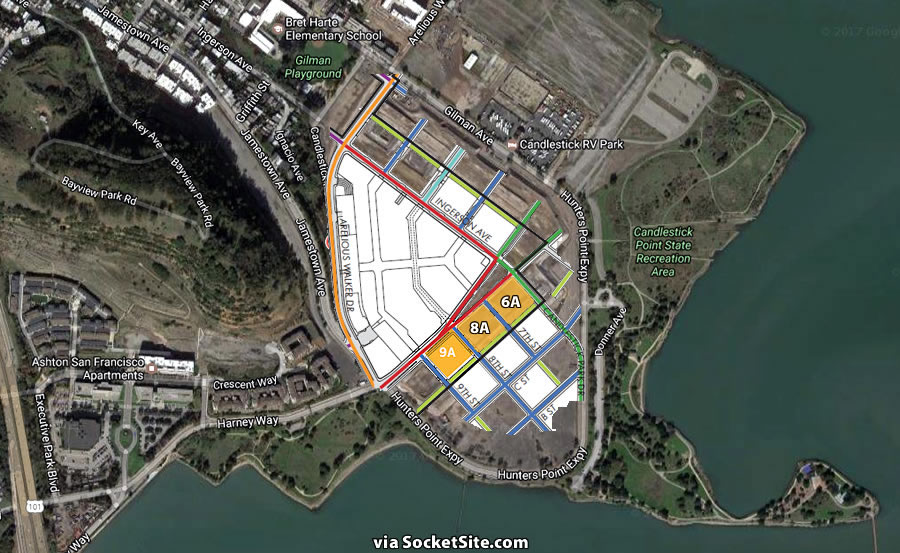
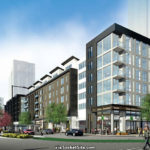
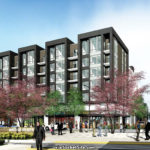
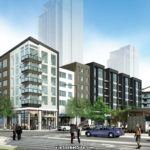
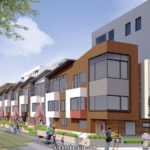
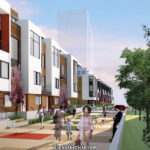
Excited for this to take shape. Considering that “the overall redevelopment of Candlestick and Hunters Point will take two to three decades to complete,” is it possible that future blocks will be upzoned? Also, is there any information yet on any of the towers in this area, currently shown ghosted in. There’ll be a whole new mini-skyline.
With respect to the two towers in the renderings above, they’re slated to rise up to 420 feet in height and will be the two tallest towers in the Candlestick Point development.
Wow how uncannily similar to what they are slapping up in this case — Fort Worth Texas, another of the world’s greatest and most beautiful cities.
At what point does the dead goose turn over in its golden eggless grave?
we live in an interconnected world with international architectural styles. You expect some unique “San Francisco” style? What would that be exactly? Art deco skyscrapers (amazingly, Art deco was an international style). Bungalows (invented in England then spread from there). Victorian (another international style spread via pattern books and new cheap manufacturing techniques…and enabled by vast supplies of cheap old growth Redwood).
You expect only local architects to get jobs? for only locally born and bred residents? and local businesses only?
Maybe if we moved San Francisco to North Korea we can create the unchanging Hermit Kingdom you seem to admire in all of your posts.
North Korean architecture might even be more appealing than this crappy, bland, uninspired, homogenous, forgettable, cookie-cutter garbage typical of most contemporary SF projects…
The 7 story condo portion looks good, but I agree those 3 story townhouses look awful. I’m generally a fan of more townhouses too.
Hysterical overstatement is not becoming. Besides, the overall vernacular in San Francisco is not that exciting anyway (Sunset, Richmond, Marina, Mission Bay). Are you expecting some kind of renaissance in design to occur in a less desirable part of the City after all of the fees, exactions, affordable housing extraction, etc.? That is just not real, folks.
Besides, I am guessing these are conceptual massing drawings.
The renderings above are not conceptual massings (except with respect to the towers), but rather the detailed designs.
I’m looking for a detailed timeline of when the Shipyard/Candlestick condos will come to the market over the next decades. I know this must be buried somewhere in the official documentation of the projects, but if anyone has a link to a more user friendly overview of the timeline, that would be very helpful. Thanks!
I don’t think the official document you seek exists. The planning documents identify the vision for the entire Shipyard/Candlestick site, but I don’t believe there is any sequential phasing of improvements discussed beyond generaities.
Lennar/Five Points seems to keep their own plans very tight to their chest. I believe they make decisions on a phase by phase basis…so the best info is what they present for planning/building approval.
I’ve been wondering if they will complete their work on Parcel A in the Shipyard and turn their attention largely to Candlestick in the mid-term, since that’s closer to the freeway and probably more marketable. We’ve heard very little about progress on design at the Shipyard aside from naming a starchitect to develop a new plan, and the naming of a leasing agent to market the site to commercial tenants.
One critical issue there seems to be no discussion of is when a better roadway connection will be built between the Shipyard and 101 – via a new bridge over Yosemite Slough (part of the master plan). I personally think Shipyard residents will be making roundabout connections for a decade or more. We will see.
Thanks for the great answer. I figured that they are keeping their cards close to the chest in order to adapt to future price shifts.
I see that the replacement housing for the Alice Griffith projects in Candlestick has advanced considerably. It should be move in ready by the end the year. The logical next step would be to raise the old projects and construct housing on that hill. It would integrate the new units with the neighborhood and link it to some public transportation (Line 29).
I think this is being considered by the project plan. Once it gets decided how much (if any) residential buildings will be build, the exact transportation plan will follow.
It’s exciting to see all that parking lot turned into a new neighborhood. I’m looking forward to seeing the same at the Coliseum when the A’s relocate to DTO and the Warriors and Raiders are gone.
What transit hub? This area of town is so far removed from mass transit that any major development will cause an uptick in congestion on the already congested roadways. Developers don’t care how people plan to get around. They just want to make a buck. The city, however, should be held responsible. Residents paying market rate prices aren’t going to ride a bus to a train (to another train or bus). They will drive.
The neighborhood transit hub will include stops for the 29 Sunset; a new CPX downtown express (which will run with a 10 minute frequency during peak hours); and a new BRT line (28L) which will run with a 5 minute (peak) frequency, connecting to Caltrain at the larger Southern Neighborhoods Transit Hub.
Exactly the issue and with the towers they need to have shovel ready plans yesterday
Ferry terminal, t-line loop out cargo way and a better plan than just BRT to balboa park station they need and upped vision to light rail or a secondary air-tram if sea level rise and muni keep getting bogged down (see 19th ave)
It’s time for a bold plan to bring a subway out here. Then stop at 3rd St, the eastern Mission along Potrero Ave, and curve over to Van Ness north of Market.
See 19th ave and lack of progress
Go with someone besides muni to build a secondary system faster air-tram
I think you are beating a dead horse with pie in the sky plans for subway expansion.
Not pie in the sky. Van Ness is one of the city’s highest priority subways to build and this is a natural place for it to go south of Market, where every other direction the tunnel could turn is already well served by transit.
Speaking of up-zoning, the plans as posted here long ago mentioned about 2.7 million square feet of R&D and office space – the office competent being only about 10% of that total IIRC. Perhaps a difference without a distinction – R&D vs office space. In any case, the “office” component of the Lennar project was under 3 million feet. Proposition O gave an M exemption for more than that. Over 3 million square feet I beleive.
What is the office component? Has it been increased from the 2.7 million figure and, whatever amount O exempted from M, is that number a firm upper limit on the amount of office space Lennar can build in the project?
I thought the current plan calls for up to 4.1 millions square feet of office space. FivePoint will be proposing to increase the commercial space to 6.6 million square feet, unencumbered by Prop M. Based on what I’ve seen and heard of David Adjaye’s new masterplan, they’re shifting towards preserving/reusing more of the historic buildings, I guess as office space.
I always thought that T-Third should loop down Gilman, through the development, over to Bayshore Caltrain and connect with the Sunnydale stop. This would give the residents the option of taking T downtown or Caltrain.
FYI, the new Yosemite Slough bridge will be reserved for transit and peds/bikes only. No automobiles. They’re missing a huge opportunity here to install light rail tracks along the route of the Bus Rapid Transit line. It would add just chump change to the cost of the project, since you’re building from scratch anyway. They’ll regret this.
U are 100% correct on the needed transit loop
Yes yes yes !!!! They need to hear this today at SFBOS hearing on prop O
I questioned the T alignment when it was first proposed (“why not directly into Candlestick or at least a spur of the line?). I was told (by a Muni planner) that Muni wanted to serve “the neighborhood” meaning the outer Portola/Vis Valley neighborhood.
We will desperately need a beefed-up T-Third AND an east-west light rail from Candlestick to SF State.
I don’t think east-west rail makes sense further south than 16th St. There are not that many big destinations, especially in the center of such a line. But under my proposed Van Ness-Potrero-Oakdale line this could be a quick two seat ride from Candlestick/HP up to Van Ness/Market (4 stops), then transfer to the M (6 or 7 stops).
100% correct
One question – how will the huge Brisbane office development affect this and traffic? As I understand it the Brisbane development was/is being criticized for having virtually no housing element. Will a lot of those workers end up occupying the HP/CP housing? Could the traffic issue be as much the commute, admittedly short, from the Brisbane development to HP/CP? Should Sam Trans consider extending a line through the Brisbane project into HP/CP – if this becomes an issue?
I think this is being considered by the project plan. Once it gets decided how much (if any) residential buildings will be build, the exact transportation plan will follow.
The light rail that makes the most sense is to take the Central Subway trains that are currently slated to turn back in Dogpatch and extend them down Third on the T, then east on Evans/Innes, wide streets allowing for a separate ROW. Then through Hunter’s Point, across the Yosemite Slough Bridge, through Candlestick, and across the planned extension of Geneva Avenue to Bayshore Caltrain, and west on Geneva to City College. This would replace the two BRT routes Muni plans, and provide a single-seat ride downtown, plus a Caltrain connection that would provide faster service downtown once electrification takes place and capacity is increased.
This is a pretty good idea. It would probably only be used for local service starting/ending east of 3rd due to the slow, horseshoe route, similar to the N along Embarcadero. But there’s enough density going into those areas that a local circulator makes sense. Another option could be to designate Candlestick as the terminus for both the Evans Ave T spur you propose *and* an extended M line from Balboa Park through Bayshore.
I’d still try to pair your idea with a subway so you can get quickly over to the Mission, Market Street and the Van Ness corridor. That creates a lot more efficient commuting scenarios like living in Candlestick and working at Zuckerberg SF General, or commuting from the many new Van Ness corridor condos to work at the Hunters Point office/R&D spaces. I think it would also be transformative in connecting new and old parts of the city.
Reminder SFBOS hearing today has Prop O on the agenda and BVHP and HPS hearing …
Best to submit transit traffic issues now before they ignore another domino effect (see 19th ave lack of vision and progress / DTX / and lacking transit planning citywide for moving people out of cars and into mass transit / central subway does not count as its a money pit….)
Transit Equity in D11/D10/D7
6.6m sf would be more that two Apple Spaceships, and nearly five Salesforce Towers!